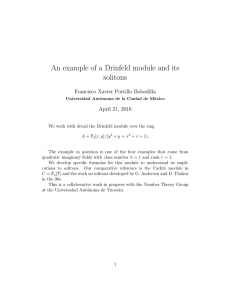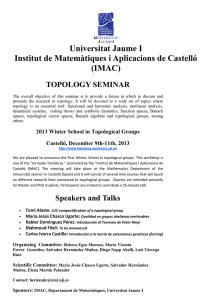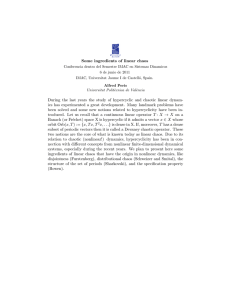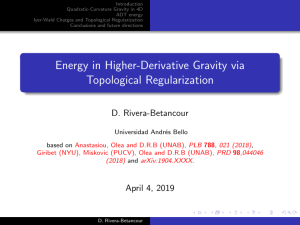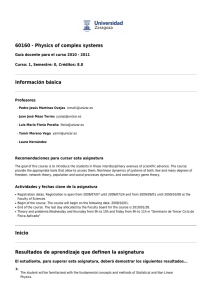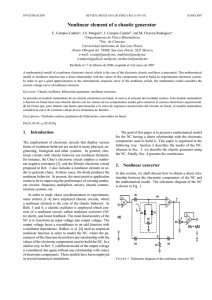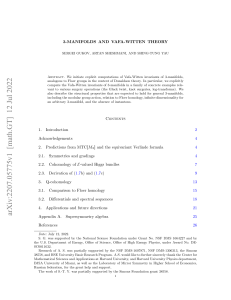Complex functions as lumps of energy
Anuncio
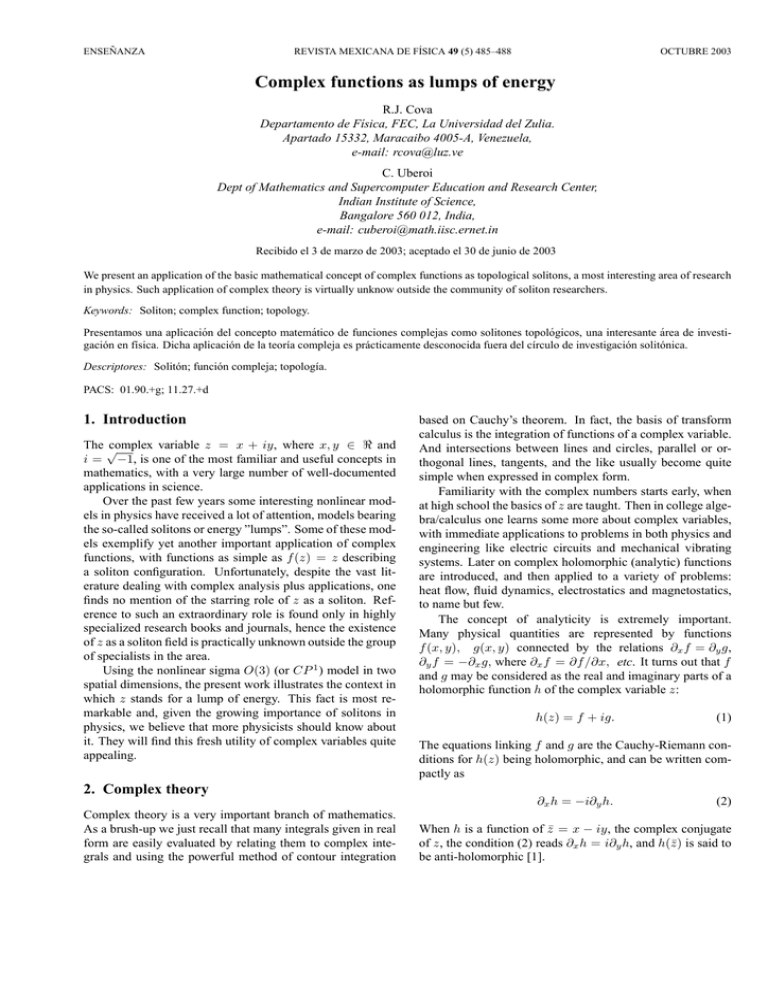
ENSEÑANZA
REVISTA MEXICANA DE FÍSICA 49 (5) 485–488
OCTUBRE 2003
Complex functions as lumps of energy
R.J. Cova
Departamento de Fı́sica, FEC, La Universidad del Zulia.
Apartado 15332, Maracaibo 4005-A, Venezuela,
e-mail: rcova@luz.ve
C. Uberoi
Dept of Mathematics and Supercomputer Education and Research Center,
Indian Institute of Science,
Bangalore 560 012, India,
e-mail: cuberoi@math.iisc.ernet.in
Recibido el 3 de marzo de 2003; aceptado el 30 de junio de 2003
We present an application of the basic mathematical concept of complex functions as topological solitons, a most interesting area of research
in physics. Such application of complex theory is virtually unknow outside the community of soliton researchers.
Keywords: Soliton; complex function; topology.
Presentamos una aplicación del concepto matemático de funciones complejas como solitones topológicos, una interesante área de investigación en fı́sica. Dicha aplicación de la teorı́a compleja es prácticamente desconocida fuera del cı́rculo de investigación solitónica.
Descriptores: Solitón; función compleja; topologı́a.
PACS: 01.90.+g; 11.27.+d
1. Introduction
The √
complex variable z = x + iy, where x, y ∈ < and
i = −1, is one of the most familiar and useful concepts in
mathematics, with a very large number of well-documented
applications in science.
Over the past few years some interesting nonlinear models in physics have received a lot of attention, models bearing
the so-called solitons or energy ”lumps”. Some of these models exemplify yet another important application of complex
functions, with functions as simple as f (z) = z describing
a soliton configuration. Unfortunately, despite the vast literature dealing with complex analysis plus applications, one
finds no mention of the starring role of z as a soliton. Reference to such an extraordinary role is found only in highly
specialized research books and journals, hence the existence
of z as a soliton field is practically unknown outside the group
of specialists in the area.
Using the nonlinear sigma O(3) (or CP 1 ) model in two
spatial dimensions, the present work illustrates the context in
which z stands for a lump of energy. This fact is most remarkable and, given the growing importance of solitons in
physics, we believe that more physicists should know about
it. They will find this fresh utility of complex variables quite
appealing.
2. Complex theory
Complex theory is a very important branch of mathematics.
As a brush-up we just recall that many integrals given in real
form are easily evaluated by relating them to complex integrals and using the powerful method of contour integration
based on Cauchy’s theorem. In fact, the basis of transform
calculus is the integration of functions of a complex variable.
And intersections between lines and circles, parallel or orthogonal lines, tangents, and the like usually become quite
simple when expressed in complex form.
Familiarity with the complex numbers starts early, when
at high school the basics of z are taught. Then in college algebra/calculus one learns some more about complex variables,
with immediate applications to problems in both physics and
engineering like electric circuits and mechanical vibrating
systems. Later on complex holomorphic (analytic) functions
are introduced, and then applied to a variety of problems:
heat flow, fluid dynamics, electrostatics and magnetostatics,
to name but few.
The concept of analyticity is extremely important.
Many physical quantities are represented by functions
f (x, y), g(x, y) connected by the relations ∂x f = ∂y g,
∂y f = −∂x g, where ∂x f = ∂f /∂x, etc. It turns out that f
and g may be considered as the real and imaginary parts of a
holomorphic function h of the complex variable z:
h(z) = f + ig.
(1)
The equations linking f and g are the Cauchy-Riemann conditions for h(z) being holomorphic, and can be written compactly as
∂x h = −i∂y h.
(2)
When h is a function of z̄ = x − iy, the complex conjugate
of z, the condition (2) reads ∂x h = i∂y h, and h(z̄) is said to
be anti-holomorphic [1].
486
R.J. COVA AND C. UBEROI
We hereby show how functions of the type (1) describe
solitons, giving yet another fundamental, if little known, application of analytic complex functions.
Using the simplest model available, below we illustrate
the emergence of topological solitons and their representation as complex functions.
3. Solitons
4. The planar O(3) model
Nonlinear science has developed strongly over the past 40
years, touching upon every discipline in both the natural and
social sciences. Nonlinear systems appear in mathematics,
physics, chemistry, biology, astronomy, metereology, engineering, economics and many more [2, 3].
Within the nonlinear phenomena we find the concept of
‘soliton’. It has got some working definitions, all amounting
to the following picture: a travelling wave of semi-permanent
lump-like form. A soliton is a non-singular solution of a nonlinear field equation whose energy density has the form of
a lump localised in space. Although solitons arise from nonlinear wave-like equations, they have properties that resemble
those of a particle, hence the suffix on to covey a corpuscular
picture to the solitary wave. Solitons exist as density waves in
spiral galaxies, as lumps in the ocean, in plasmas, molecular
systems, protein dynamics, laser pulses propagating in solids,
liquid crystals, elementary particles, nuclear physics. . .
According to whether the solitonic field equations can be
solved or not, solitons are said to be integrable or nonintegrable. Given the limitations to analitycally handle nonlinear equations, it is not surprising that integrable solitons are
generally found only in one dimension. The dynamics of integrable solitons is quite restricted; they usually move undistorted in shape and, in the event of a collision, they scatter off
undergoing merely a phase shift.
In higher dimensions the dynamics of solitons is far
richer, but now we are in the realm of nonintegrable models. In this case analytical solutions are practically restricted
to static configurations and Lorentz transfomations thereof.
(The time evolution being studied via numerical simulations
and other approximation techniques.) A trait of nonintegrable
solitons is that they carry a conserved quantity of topological nature, the topological charge –hence the designation
topological solitons. Entities of this kind exhibit interesting
stability and scattering processes, including soliton annihilation which can occur when lumps with opposite topological
charges (one positive, one negative) collide. For areas like
nuclear/particle physics such dynamics is of great relevance.
Models in two dimensions have a wide range of applications.
In physics they are used in topics that include Heisenberg
ferromagnets, the quantum Hall effect, superconductivity, nematic crystals, topological fluids, vortices and solitons. Some
of these models also appear as low dimensional analogues of
forefront non-abelian gauge field particle theories in higher
dimensions, an example being the Skyrme model of nuclear
physics [4, 5].
One of the simplest such systems is the O(3) or CP 1
sigma model in (2+1) dimensions (2 space, 1 time). It involves three real scalar fields φj (j=1,2,3) functions of the
space-time coordinates (t, x, y) [6, 7]. The model is defined
by the Lagrangian density
3
L=
1X
[(∂t φj )2 − (∂x φj )2 − (∂y φj )2 ],
4 j=1
(3)
where the fields, compactly written as the vector in field
~ ≡ (φ1 , φ2 , φ3 ), are constraint to lie on the unit sphere
space φ
(φ)
S2
~:φ
~ 2 = 1}.
= {φ
(4)
The Euler-Lagrange field equation derived from (3)-(4) has
no known analytical solutions except for the static case,
which equation reads
~ − (φ.∇
~ 2 φ)
~ φ
~ = ~0
∇2 φ
[∇2 ≡ ∂x2 + ∂y2 ].
(5)
The CP 1 solitons are non-singular solutions of (5). Without the constraint (4) the said equation would reduce to
~ = ~0, whose only non-singular solutions are constants.
∇2 φ
The condition (4) leads to the second term in (5), equation
which does yield non-trivial non-singular solutions as we will
later see.
Solitons must also be finite-energy configurations.
From (3) we readily get the static energy
Z
Z
3
3
1X
1X
[(∂x φj )2 +(∂y φj )2 ] d2 x=
(∇φj )(∇φj ) d2 x[∇ ≡ (∂x , ∂y )]
4 j=1
4 j=1
Z
1
~
~ rdrdθ (in polar coordinates r, θ).
(∇φ).(∇
φ)
=
4
We ensure the finiteness of E by taking the boundary condition
E=
~ θ) → φ
~0
lim φ(r,
r→∞
(a constant unit vector independent of θ),
Rev. Mex. Fı́s. 49 (5) (2003) 485–488
(6)
(7)
487
COMPLEX FUNCTIONS AS LUMPS OF ENERGY
since the integrand in (6) will thus tend to zero at spatial infinity:
r
~
~ 2 + ( 1 ∂θ φ)
~ 2 → 0. (8)
lim r|∇φ| = lim r (∂r φ)
r→∞
r→∞
r
projection
W =
~ − (φ.∇
~ 2 φ)
~ φ
~
~τ = ∇2 φ
~ in the marble representing the tension in the
at the point φ
rubber at that point. Thus the map is harmonic if and only
~ constrains the rubber to lie on the marble in a position
if φ
of elastic equilibrium, ~τ = ~0, which is just Eq. (5). These
are our finite-energy configurations, of which the soliton solutions are a subset.
4.2. Topological charge
In general, as the coordinate z = (x, y) ranges over the
(x)
~ = (φ1 , φ2 , φ3 ) ranges
sphere S2 once, the coordinate φ
(φ)
over S2 N times. This winding number is called the topological charge in soliton parlance, and classifies the maps
(x)
(φ)
S2 → S2 into sectors (homotopy classes); maps within
one sector are equivalent in that they can be obtained from
each other by continuos transformations.
An expression for the topological charge is obtained by
(φ)
expanding the coordinates φj of the area element of S2 in
(x)
terms of coordinates (x, y) in S2 , and integrating off. In
plainer language, from the college formula that computes the
~ through a region D of a surface S :
flux of a vector A
Z
~ ndS [b
A.b
n a normal unit vector],
(9)
(10)
In this formulation, the topological charge is given by
4.1. The complex plane
We are thus considering the model in the x − y plane with
a point at infinity, i.e., the extended complex plane which
(x)
is topologically equivalent to the two-sphere S2 . The fi~ defined on
nite energy configurations are therefore fields φ
(x)
(φ)
∼
<2 ∪ {∞} = S2 and taking values on S2 . In other
words, our finite-energy fields are harmonic maps of the form
(x)
(φ)
S2 → S2 [8].
(x)
We may imagine the coordinate space S2 as made of
(φ)
rubber and the field space S2 as made of marble; the map
~ constrains the rubber to lie on the marble. Then with each
φ
point (x, y) in the rubber we have a quantity
φ1 + iφ2
.
1 − φ3
N=
1
π
Z
(x)
S2
|∂z W |2 − |∂z̄ W |2 2
d x,
(1 + |W |2 )2
N ∈ Z,
(11)
connected with the energy (6) through
E ≥ 2π|N |.
(12)
5. Lumps
The solitonic solutions we seek correspond to the equality
in (12) [9–11]. That is, in a given topological sector N the
static solitons of the planar CP 1 model are the configurations
whose energy E is an absolute minimum. Combining (11)
with E = 2π|N | we find that solutions carrying positive or
negative topological charge satisfy, respectively,
∂z̄ W = 0 → ∂x W = −i∂y W,
(13)
∂z W = 0 → ∂x W = i∂y W.
(14)
But recalling Eq. (2) we immediately recognise the above
equations as the Cauchy-Riemann conditions for W being a
holomorphic function of z or z̄. This is most remarkable.
For instance, a single-soliton solution (N = 1) may be
described by
W =z
[note that this satisfies equation (13)];
(15)
its energy density distribution is given by
E=
2
.
1 + |z|2
(16)
Plots of (16) reveal a lump of energy localised in space, as
shown in Fig. 1. The same energy corresponds to W = z̄,
which has N < 0 and sometimes is referred to as an antisoliton.
D
the topological charge N follows by calculating the flux of
~ through the sphere S (x) of radius a = 1:
~ = (N )/(4πa2 )φ
A
2
Z
Z
N ~~
~ ndS →
φ.φ dS = N.
A.b
(x) 4πa2
D
S2
Notably, a field with topological charge N describes precisely a system of N solitons.
In order to actually find charge-N finite-energy solutions,
it is convenient to express the model in terms of one inde~ via the stereographic
pendent complex field, W , related to φ
F IGURE 1. The energy distribution corresponding to the soliton
W=z.
Rev. Mex. Fı́s. 49 (5) (2003) 485–488
488
R.J. COVA AND C. UBEROI
A more general N = 1 solution is given by a rational
function W = λ(z − a)/(z − b), which we should note is
non-singular: W (z = b) = ∞ corresponds to φ3 = 1, the
(φ)
north pole of S2 according to (10). A prototype solution for
arbitrary N > 0 is λ(z − a)N .
The dynamics of these structures is studied by numerically evolving the full time-dependent equation derived
from (3), with the fields W (z) as initial conditions [12, 13].
Sigma CP 1 -type models have several applications, noteworthy among them being the Skyrme model in (3+1) dimensions where the topological solitons stand for ground states
of light nuclei, with the topological charge representing the
baryon number.
The role of complex functions as topological solitons deserves widespread attention and should not be missing from
the modern literature dealing with complex theory and its applications.
1. A. Lars, Complex Analysis (McGraw-Hill, 1979)
2. Lui Lam (editor), Nonlinear Physics for Begginers (Worldscientific, 1998)
3. M. Lakshmanan (editor), Solitons: Introduction and Applications (Springer-Verlag, 1988); Proceedings of the Winter
School on Solitons January 5-17 1987, Bharathidasan University, Tiruchirapalli, India
4. T.H.R Skyrme, Proc. R. Soc. A 260 (1961) 127.
5. T.H.R Skyrme, Nucl. Phys. 31 (1962) 556.
6. R. Rajaraman, Solitons and instantons (North-Holland, 1987)
7. W.J. Zakrzewski, Low Dimensional Sigma Models (Adam
Hilger, 1989)
Acknowledgements
R.J. Cova thanks the Third World Academy of Science
(TWAS) for its financial support and the Indian Institute of
Science (IISc) for its hospitality. The support of La Universidad del Zulia is greatly acknowledged. The authors thank Mr
A. Upadhyay for helpful conversations.
8. J. Eells and L. Lemaire, Bull. London Math. Soc. 10 (1978) 1.
9. R. Takagi, Jour. Dif. Geom. 11 (1976) 225.
10. A.A. Belavin and A.M. Poliakov, JETP letters 22 (1975) 245.
11. G. Woo, Jour. Math. Phys. 18 (1977) 1264.
12. R.A. Leese, et al. Nonlinearity 3 (1990) 387.
13. R.J. Cova, Euro. Phys. Jour. B 23 (2001) 209.
Rev. Mex. Fı́s. 49 (5) (2003) 485–488
